Identification
True armyworm (also known as common armyworm), when full grown, are 4 cm (1 1⁄2 in.) long. They can vary in colour from dull-green to brown or black. Two distinguishing features are orange stripes bordered by a thin white line running laterally along the body and dark horizontal bands at the top of each abdominal proleg. Their head is yellow-brown with a network of dark-brown lines creating a mottled pattern. The adult sand-coloured moth has distinctive white spots in a line down the centre of each forewing and dark spots at the ends of their wing that form a chevron when brought together.
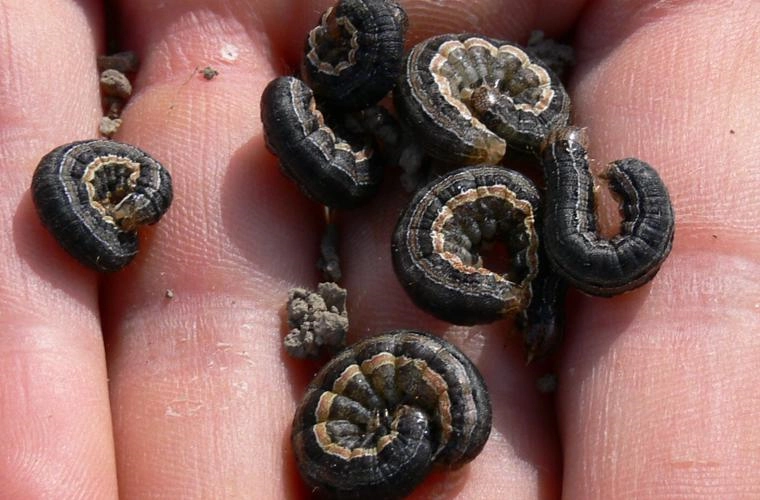
Often confused with Fall Armyworm
The fall armyworm larvae (figure 2) can be distinguished from the true armyworm by a white, inverted “Y” on the front of the head. The fall armyworm head is dark brown to black. Though the larvae have similar stripes to the true armyworm, fall armyworm larvae also have elevated spots with hair sticking out of each one. Four of these spots form a square on the top of the last abdominal segment of the larvae. Unlike true armyworm (figure 3), fall armyworm do not have black bands on their prolegs (chubby back legs).
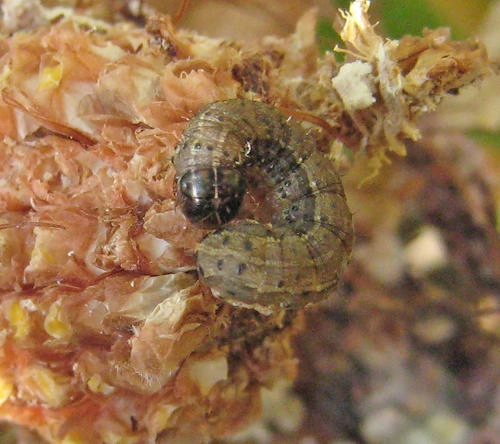
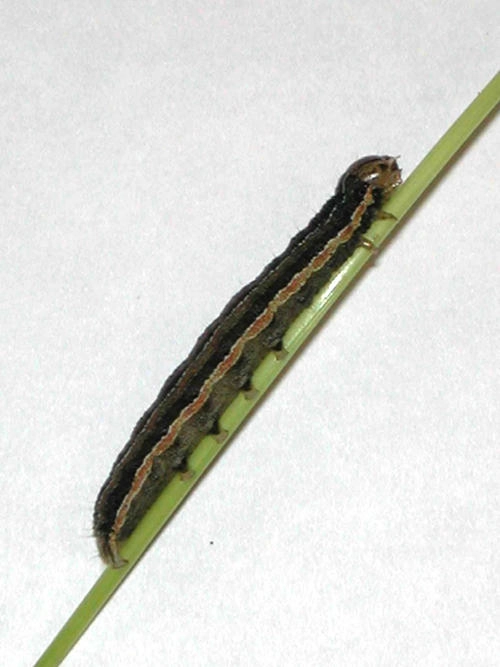
Biology
True armyworm is a sporadic pest with outbreaks occurring every 4 to 6 years. They overwinter in the southern states and are carried in as moths via storm fronts in early spring (figure 4). Moths prefer to lay their eggs in grassy vegetation, including cereals, grassy forages and rye cover crop. Larvae hatch from the eggs and feed at night or on overcast days for approximately a month. There are two to three generations per year, but it is the first generation that tends to do the most damage to corn in Ontario. Outbreak years tend to coincide with cool wet springs that are detrimental to the parasites that typically control armyworm.
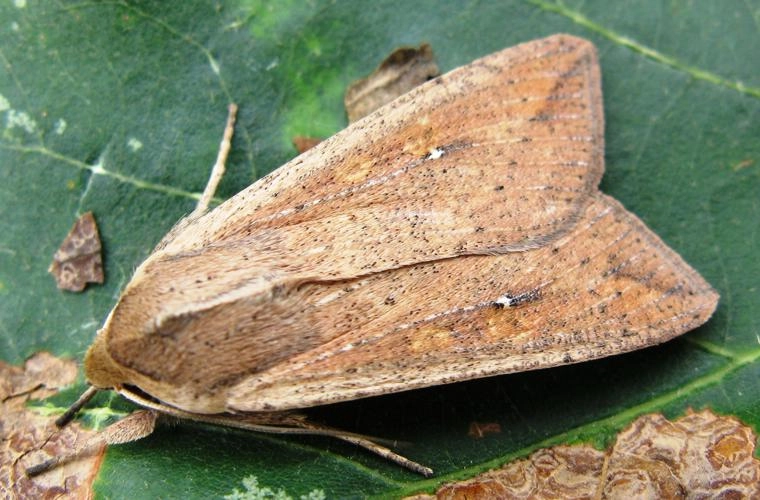
Period of Activity
Adult moths can arrive as early as April and are captured in pheromone traps until late August. Larval activity in corn and wheat can begin as early as mid-May to July.
Scouting Notes
Infestations may develop throughout the field, but infestations may also move in from neighbouring fields. In cereals and mixed forages, feeding begins on the leaf margins, but larvae may quickly move up the plant to feed on the kernels and awns or clip the wheat, timothy or other small grains heads completely off of the stem. Clipped heads can be found on the soil surface and can impact yield if taking place in many areas of the field.
True armyworm feed at night, so the best time to scout for true armyworm is shortly after dusk. In cereals, examine 10 areas of the field, assessing the number of larvae per 30 cm x 30 cm (1 ft2). Pay particular attention to the border area directly adjacent to other grassy host crops.
During the day, if it is cloudy and overcast, you might be lucky enough to see larvae on the head of the plant but on sunny days, they will be down on the ground among the crop debris or under soil clods (figure 5). Brown frass may also be present on the plants and on the soil surface. Birds diving into your field is a good indication that there are good eats there, so take a look.
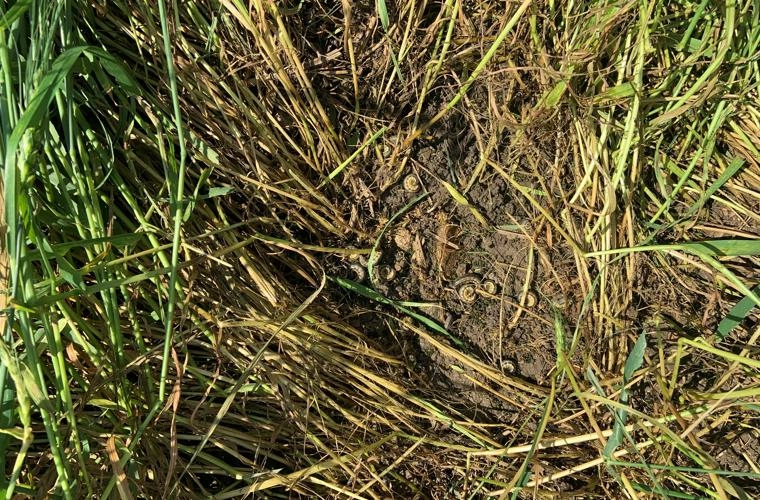
Always take the time to look for any white eggs that may be attached to the backs of the armyworm larvae. This is a sign that the larvae have been parasitized by one of its parasites which have done the job for you.
Thresholds
Chemical control is warranted if there are 4 to 5 un-parasitized larvae (smaller than 2.5 cm) per square foot. If a significant amount of wheat head clipping is occurring, spray may be warranted if larvae are still actively feeding, are smaller than 2.5 cm (figure 6) and as long as pre-harvest intervals have not been reached.
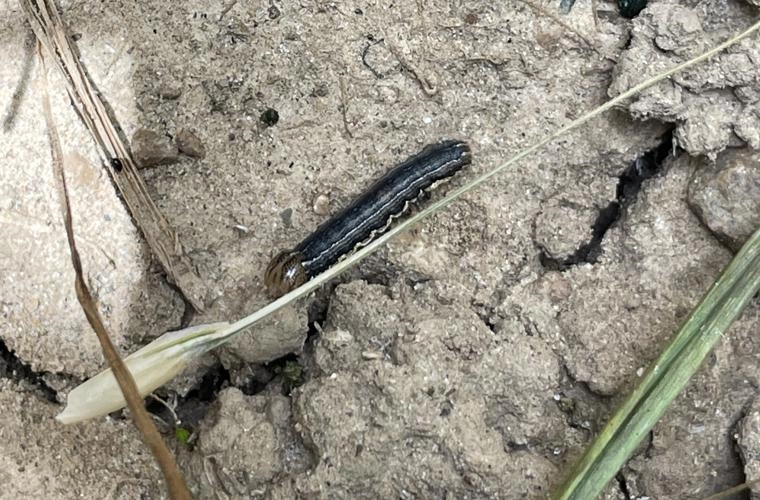
If wheat heads are being clipped off and larvae are still present in the field and smaller than 2.5 cm, control may be warranted. Leaf feeding in wheat that is past the soft dough stage will not affect yields so insecticide treatment is not necessary.
Management Notes
Cultural Control
- Ensure effective management of grassy weeds and volunteer cereals.
- Fields adjacent to wheat fields are at higher risk in outbreak years.
- Early planted winter wheat can sometimes avoid injury during critical flag leaf to early heading stages.
Chemical Control
- If the larvae are over 2.5 cm (1 in.) long, there is no benefit in applying insecticide, since most of the feeding damage has already occurred.
- Treatment may be confined to infested areas. If armyworm are migrating from adjacent host fields, spraying an insecticide along the field border may be sufficient.
Biological Control
- Predators like lady beetles, minute pirate bugs and spined soldier bug can feed on egg masses and younger TAW larvae.
- A number of different parasitoids are associated with true armyworm. Tachinid flies often lay eggs on larvae.
- Avoid treating with insecticides when large numbers of parasitized larvae are present.
- Many entomopathogen fungi and viruses help reduce populations if conditions are favourable for their development.